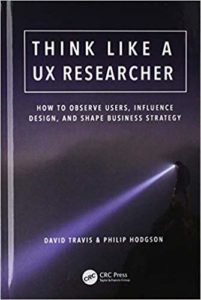Earlier this year, an important new book for the field of UX was published—Think like a UX Researcher, by David Travis and Philip Hodgson.

Given the quality of advice provided by the authors over many years in the UX field, I had high expectations for the book. And sure enough, if you already work in or you’re considering working in UX research, I recommend this book as an essential read—not just to read once, but to keep with you as a reference to dip into, to help you reflect on current practice, and to evolve your knowledge and skills.
The book doesn’t directly talk about involving people with disabilities in user research. But it contains a lot of valuable advice that can guide you if you’re looking to develop your accessibility and UX strategy to include user research with people with disabilities.
At TPG, we believe that involving people with disabilities in UX research is a valuable part of accessibility strategy, complementing the integrating of accessibility into design, development and QA processes. So this is the first in a series of posts that will look at some specific topics covered by the book and how they might apply in a disability-focused research context.
Defining your UX research problem
Involving people with disabilities in UX research should be about trying to answer meaningful questions that help you solve a problem. Without meaningful questions you risk wasting time and money.
At the most basic level, a research activity either seeks to learn about a problem in order to inform the design and development of a product or service, or it seeks to evaluate the effectiveness of a solution to a problem. If you’re trying to learn more about a problem, then it’s important to define that problem first. Helpfully, Travis and Hodgson’s book lists four techniques to help identify a research problem and turn it into a question or questions that can become the focus of a research activity.
Let’s look at each technique from the perspective of involving people with disabilities in UX research.
1. Find out what other stakeholders need to know
There are many potential beneficiaries of a research activity that involves people with disabilities. What would they find most useful to know? What data would help them most with decision-making?
Identify the stakeholders who could benefit from data emerging from a research study with people with disabilities, including the product development team that will ultimately be expected to act on the results. Talk to them about the proposed research and their awareness, attitudes, and information needs.
This will help you to prioritize goals and identify challenges in research design and delivery. It will also help ensure that stakeholders know about the activity and have the opportunity to be involved.
2. “Deconstruct the construct”
Travis and Hodgson explain that user research studies typically explore constructs. These are abstract concepts that are important attributes when you think about a digital experience, like usability and privacy, but which need to be broken down into components to become measurable.
How might you deconstruct a construct like usability or privacy from the perspective of someone with a disability? People with disabilities are people—they share needs, goals and values that other members of a product’s or service’s target audience have, but with the additional influence of accessibility requirements. What aspects of user behavior are particularly important to understand from a disability perspective? What features and functionality are most helpful? How might we assess the quality of content, language and tone of accessibility support provided by a product or service?
3. Measure something
When you break down constructs, you can start to identify things to measure. This in turn helps quantify a problem, allow objective benchmarking and comparison, and generate business-relevant data. Once you know what to measure, you can then think about designing an activity that can capture reliable and meaningful data.
Involving people with disabilities means that you need to carefully select and apply methods of measurement that take into account the nature of their disabilities. For example, keystroke logging can be a useful data capture method for a usability study, but capture and analysis will be more complex when participants use shortcuts provided by screen readers, and of limited use for people using alternative input methods such as voice.
With accessibility, there are also ready-made tools that can be used for measurement, including standards such as the Web Content Accessibility Guidelines. They can provide a helpful triangulation of results from UX research.
4. Shake out the issues
Travis and Hodgson note the value of a pre-pilot study before a full research activity, to quickly and cheaply identify issues that may affect the success of the activity. In their words, a pre-pilot study’s focus is “airing a research problem and getting it front of some users to help flush out any issues before advancing further.”
Talk to a small number of people with disabilities as part of the planning stage of the research activity. This might give insight into the components of a design problem that causes you to challenge your assumptions, and rethink how you would design a research activity to explore the problem. For example, you might learn that what you thought was a problem for a particular disability group isn’t much of an issue at all, whereas a related issue you hadn’t thought about needs much more attention.
Next up…
Once you have a firm understanding of the questions you want to answer and the data you want to gather, your next concern may be how many participants to include. In Think like a UX Researcher, Travis and Hodgson give some useful guidance on that topic, so it’s the focus of the second post in this series.